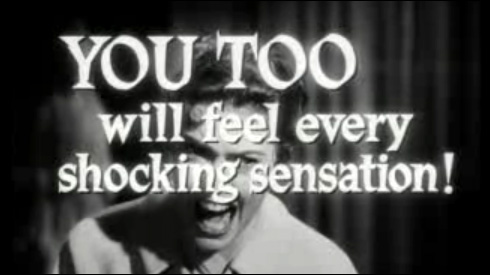Tue 8 Jun 2010
3D Really IS Going To Kill You. I MEAN IT This Time! Stop Laughing!
Posted by anaglyph under Australiana, Idiots, In The News, Silly, SmashItWithAHammer, Stupidity, Technology
[23] Comments

Yes, I know I’ve talked about it several times already, but this time it’s serious.
‘Cyber sickness’ warning ahead of 3D revolution’ screams the headline. Again, you will not be at all surprised to learn that it’s from the Melbourne Age.
Up to 10 per cent of people who watch 3D images on television, at the movies or while gaming suffer ”cyber sickness” symptoms such as blurred vision, nausea and dizziness, health experts have warned.
Those experts! If it wasn’t for them, the world would be a much cheerier place. But wait! It’s WORSE THAN YOU THINK:
But they say the number of people affected by cyber sickness could rise to unknown proportions with the advent of the 3D TV era…
Did you hear that? UNKNOWN PROPORTIONS! It could be a veritable cyber-sickness pandemic. Forget getting immunised for swine flu – if these experts are right we’ll all be taking major doses of stereoids to fend off the 3DTs.
The article gushes breathlessly onward:
Virtual reality pioneer Mark Pesce, an honorary lecturer at the University of Sydney, said the majority of occasional 3D viewers would love the experience, but he warned that the health effects of heavy use of 3D media – which trick the eye by changing the depth perception of a person’s vision – had not been tested.
Um… actually, that’s not how 3D works at all – there is no ‘tricking the eye by changing depth perception’ Mr… who wrote this damned thing… let’s just scroll back up to the by-line… oh, WHAT a surprise. It’s Stephen Cauchi, King of the the Non-News at the wheel again. Geez. Have they hired this guy specifically to reduce the Age’s credibility or something? ((I swear I’m not witch-hunting this guy. I literally did what I just wrote – I was reading the article and thought ‘Man this is terrible!’, looked at the byline…)) Anyway, to continue, 3D works by exploiting the effect of stereopsis which is the natural way we achieve depth perception. What Mr Cauchi just said is word fluff. It is completely free of actual meaning.
Like last post’s Government Weather Control article that we saw from Mr Cauchi, as the story continues the sensible people start to appear, and we find Victorian Eye and Ear Hospital ophthalmologist Lionel Kowal saying that the number of people who reported problems with 3D is ‘probably closer to 5 per cent than 10 per cent.’ Then, we hear from Kathryn Rose, an associate professor in orthoptics at the University of Sydney, who thinks that ‘about 3 per cent of the population would not be able to watch 3D TV’.
3 percent? 3 percent? Do I hear 2 percent? 2 percent over in the back? 1.5 percent? Can I get a 1?
The article ends with a quote from Newcastle University neurobiologis Alan Brichta:
‘Right now we don’t have all the information but my gut feeling says [cyber sickness] is not going to be a major issue.’
Are you with me here in this insanity, dear Acowlytes? We’ve gone from an epidemic of ‘cyber sickness’ of UNKNOWN PROPORTIONS to ‘er.. actually, not a major issue…’ in the space of one information-free waffle fest.
Like the Government Weather Control story, I propose this whole air-headed notion could have been summed up in one short sentence:
A tiny minority of people might find 3D media a little unsettling but most people won’t.
Again, short on pizazz, but it’s exactly the same content and it would have saved precious digital bits for something that was actually worth calling NEWS.




Waffle fest? I’m in! Pass the syrup.
I think you mean ‘Pass the Torani!’ (There’s a definite smell of ham about all this, that’s for sure)
Two quick responses…
1. Maybe, as Language Log suggests, We Need More Bad Science Writers.
2. Maybe going to Mark Pesce’s original essay is a better bet? [Disclosure: I know Mr Pesce reasonably well and occasionally drink with him.]
Well, I didn’t wallop Mr Pesce as you noticed because what he said actually made sense (the bit about 3D ‘tricking the eye’ are not his words, I’m fairly confident). In fact, ALL the people quoted in the article actually made sense. It’s the unattributed ‘experts’ and Stephen Cauchi who fail to bring anything useful to the party.
Thanks for the Language Log link :-)
Later…
Now, see, what Mark Pesce talks about is reasonably rational and sensible, if a little heavy on the ‘Oh my God – think of the children!’. Why didn’t Stephen Cauchi paraphrase that, or better still, just not bother at all and get the Age to put up a link to Mr Pesce’s article. It would have spared us all some grief AND done some public good.
For what it’s worth, as I prepare to go off to the US of A to work on a ginormous film that will almost certainly now be made in 3D, I agree with Mark Pesce’s prognosis that it won’t last – but not for the same reasons. Even though I quite like the 3D experience, the recent eruption of it is a pox on the cinema, in my opinion. Very few films use stereoscopy properly, and very few are justified in adopting it. I predict that its present incarnation will die a death as people get sick of the novelty and of wearing the glasses every time they want to watch something. As a home tv kinda thing – doubly poxxed. The video game industry has been trying it for years and it’s failed and failed and failed. There is no reason to believe that any of the impediments have been overcome for tv or for gaming.
The Reverend’s Forecast? 3D dead by the end of 2011, except maybe for a few big animation films.
Dead by 2011? I don’t think so. But that might be my own biases talking.
I get really excited about 3D stuff. I love it, I’ve got about $3,000 of stereo equipment (two 800×600 OLED 3D headsets, one pair shutter glasses, and a variety of red/cyan etc glasses).
I’m really looking forward to it becoming more mainstream.
To me, it looks like this will require one of two things:
1) people to accept wearing headsets as part of their casual viewing (not a huge problem for specs wearers, if the displays could be made small enough, but a big problem for everyone else apparently), or
2) non-goggle stereo TV development to allow a much wider field of view (at the moment the “sweet spot” for these screens is far too small for multiple people to watch the screen at once). Samsung used to be the only player in that market, but now Sony’s joined the fight, so it’s getting fun!
With the advent of nVidia (which provides built in driver support for 3D on all their cards) and DirectX & OpenGL (which means all modern games are using one of two systems to represent 3D, so you don’t need game makers to make their game deliberately 3D compatible any more), and the availability of cheap shutter glasses ($20 or less), 3D gaming has come of age: anyone can play any 3D game in 3D now, for the price of a KFC family bukkit.
And with Blu-Ray having won the format war, 3D movies at home are now practical.
It’s kinda naïve to call 3D a gimmick, I think: it shows a lack of awareness of movie history. Stereo sound, surround sound, and others, all were initially used as gimmicks, for “cheap shots” to make the audience squeal as they heard the bad guy behind them. The same with 3D: at first it was done for the gimmicks, but they became stale fast, and instead the more sensible directors are using it for depth.
I think Avatar’s a good example of 3D camerawork done right: there were very few cases where stuff “came out the screen” – most of it was extra depth in-screen. Even in the scene where the hero was fighting off dogs with a torch on a stick, spinning around and flailing, it seemed like great care was taken to NOT poke that stick at the camera. When he was stuck under a tree and you saw from his viewpoint a giant tigery thing clawing at him, the claw-swipe didn’t extend out of the screen, even though it was very in-your-face (yeah, I saw avatar three times, so I started noticing the care they’d taken with this stuff). I think the smoke grenades going into the tree was the only exception I noticed: one bounced towards the camera.
Even Youtube’s now showing 3D stuff, which you can watch cross-eyed (my preference), wall-eyed, or using goggles of various sorts, by selecting from a “3D” menu at the bottom of the video.
The best immersion for gaming will always be head-mounted displays with head-tracking, so you can turn your head and see. These are still large, expensive and low-res ($1500 gets you one 800×600 display per eye, plagued with dead pixels – not that you notice those in stereo applications – a compass, three accellerometers, a gyroscope, and earbuds), and worse, they are tethered to the computer by a fat cable, which means if you turn around once, you’re entangled!
The main problem there is that the drivers are crap, I feel, and not designed for the typical gamer, who’s sat in his chair: I’ve got the SDK for my two displays, and it should be easy enough to write drivers that act like a mouse for small head turns, but more like a joystick for large ones. So if you turn your head, say, 45 degrees, then your character will turn the same amount. But if you turn 90 degrees, your character would rotate continuously, rather than just turn by 90 degrees. That this is needed feels a bit obvious to me, and I don’t see why it hasn’t already been done.
Mainstream acceptance of 3D is also an essential step towards mainstream acceptance of mediated reality, since it’ll mean 3D headsets become small enough and portable enough to be wearable in the street without looking like a cylon.
Having nailed my colors to the mast, I guess I should now defend the technology against the crap being flung at it.
Specifically the completely unsubstantiated bullshit that having missing depth cues will permanently destroy the depth perception of children.
So I wrote that, but it was even longer than my normal epic comments, so I blogged it.
Well, I actually agree with most of what you say, but I stick by my assessment of what will happen with movies. Until the glasses go away, and people get some understanding of how we actually see, 3D in movies is destined to suck.
I too am a big fan of stereoscopy. I’ve had a Stereo Realist camera for some thirty years and have taken hundreds of stereo photographs. I have seen pretty much every major 3D film ever made, including the 3D version of Hitchcock’s Dial M for Murder. But here’s the big difference between 3D and all the other technical innovations you mentioned (stereo sound, colour, surround etc): all of them became mainstream in their first incarnation, pretty much. 3D in movies has had attempts every decade since the ’50s and has never managed to gain a foothold. I think there are numerous reasons for that. The first and most obvious one is that you have to wear some kind of headgear to see the 3D effect. I think people will put up with that once in a while for a special theatre experience, but not as a general habit. I wear spectacles all the time, and the 3D glasses annoy the crap out of me.
A second major reason that I can think of is that even very good 3D is rarely anything more than a novelty – out of the recent crop of big 3D films, the only one that I think uses stereoscopy well is Monsters Vs Aliens. (The 3D in Avatar is good only when the story moves to Pandora and we’re in complete CG. The early scenes were, in my opinion, terrible. There were egregious mistakes – you NEVER have things out of focus in the foreground with 3D. Your eye just doesn’t work like that. Also, reflections behaved oddly – I’ve only seen the film once so I’d have to look at it again to pinpoint why, but I was aware of odd disparity with reflections on glass visors and windshields on a number of occasions. There were also some weird scale problems – a few scenes had soldiers that looked like pixies (a problem with the spacing of the cameras which makes things look smaller than they should)). As you said on your own blog, 3D comes into its own only when you have maximum or infinite depth of field. This is very hard to achieve in real photography, but easily done with CG. That’s why I qualified my ‘3D will die’ comment with an exception for animation. Animation can pull it off. Until the 3D is a part of the film process, rather than a drawcard to get people to come to the movies, it’s destined to stay a gimmick. And personally, I think it’s a LONG way from becoming an uncontrived addition to films.
A third reason is that I believe for some people, maybe even a lot of people, the stereoscopic experience is just not that spectacular. I’ve noticed this when I show friends my stereoscopic photographs. A suitably large number of them failed to be impressed (and I like to believe that it’s not the photography that underwhelms them). They just don’t ‘get’ 3D. This has puzzled me from the very first time I started making stereoscopic pictures. And now I’m hearing a lot of people say exactly the same thing about 3D movies – ‘Meh. They’re alright. I don’t get what the whole 3D thing is about’. It sounds like they can’t even see the 3D effect! Now I’m prepared to think that a few people don’t have good natural stereoscopy, but I hear the comment much more than I would have thought likely. I can’t explain it, but without doing some science it occurs to me that we don’t actually know how good the general perception of stereoscopy is. Just as a large percentage of people are colourblind, maybe an even larger percent have very minimal stereoscopy.
There are other reasons I can think of, but I’m already overlong for a comment.
Ooh, you’ve noticed the “Meh, it’s OK” thing too? Yeah. I’ve wondered about that a lot: you get it in just about every group of people discussing 3D. There are those who can’t see the 3D, there are those who love it, and there’s the people who just… aren’t interested.
My current theory is that stereoscopy is something we each develop, individually, in reaction to the incoming signals, in our first few months of sight. So different people will develop different solutions to it, putting different “importances” to divergence as a cue. To some (like me) it makes a vast difference. To others, it’s just giving a slight amount extra depth to what they were already getting just fine from a 2D image. I’ve no idea how that hypothesis could be falsified, though.
I wonder if “3D-meh”ers would score differently to the “3D-wow”ers in tests in which just one depth cue were visible.
Of course, it could just be that they just genuinely aren’t interested: it’s not something they want to concern themselves with one way or another. Except, it seems more common than apathy about most other stuff.
The “weird reflections” thing makes me guess you watched the movie through linearly polarised glasses. When light bounces off a surface at an angle, it becomes polarised. I found this showed up well when I looked out at the carpark through the glasses: one eye could see into the cars, the other could see only reflected sky in their windscreens.
Polarised sunglasses and helmet visors use this effect to cut down much more than 50% of the “road glare”.
But… for it to be visible on the screen means it must have been *recorded* like that too, which seems a bit strange.
I agree that 3D isn’t perfect yet. But I don’t think it’s going away this time: I think this time, we may just have the technology to give it legs.
What I *don’t* agree is that omitting depth cues could possibly destroy children’s sense of depth perception.
Speaking only for myself, I can certainly see the 3D effect in the demo TVs I’ve seen, so it’s not a lack of perception. It’s more a “Gosh, and so what?” from a creativity / astonishment perspective. It’s a gimmick, and for me the gosh-wow aspect of a gimmick wears off in about ten seconds.
Similarly, I’m not at all interested in the recreational fear of roller coasters or bungee jumping, and I rarely go “Wow that’s amazing!” when seeing any supposedly new and exciting technology.
Maybe it’s more a personality style than a perception thing.
It’s a good point. Speaking for myself, I actually really LOVE the 3D effect when it’s done well. Looking at really sharp 3D stills is breathtaking for me. But other people just don’t ‘get’ what I’m seeing, apparently.
I also like gadgets. But I can pass on the rollercoasters.
For what it’s worth, about ten years ago I had a comprehensive eye exam and the optician was super impressed with my stereo acuity. I got a score of about 99% which he’d never had. I don’t know if that means anything…
Rollercoasters are a really good comparison, actually. For me, they’re awesome, and for me, the best are the “rocking boats”. But loads of people just think they’re meh. I guess 3D’s like that.
Perhaps 3D fans are deficient in other depth cues. So for example, I always meh’d at nebula pictures that other people thought beautiful enough to put on photos, but looking at them in 3D, I realised how beautiful they are (google image search: 3D nebula)
Also: anaglyph, I only just realised how stupid I was to be surprised to find that you’re a 3D fan too. You know, given your username and all. The connection just never made itself in my head.
I don’t have a ‘meh’ reaction to rollercoasters. I have more of a ‘FUCKING-HELL -GET-ME THE FUCK-OFFA-THIS-THING I’M GOING-TO-DIE!’ reaction.
So I totally know why I don’t like rollercoasters – they scare the crap out of me.
As far as the ‘anaglyph’ thing goes – I did wonder if I was being a bit clever for my own boots…
I wonder if anyone has ever done a study on the effects of pseudo-journalism (or Yellow Journalism, or whatever name you call it where you are). I expect a significant number of housewives incur higher levels of stress from watching soaps and reading articles like these (which can be found in almost any of those periodicals, like The Sun, National Enquirer, etc.). I mean, couldn’t anyone claim that anything that hasn’t been thoroughly tested could cause an ‘unknown percentage of bad stuff’ to happen? So far, zero percent is inclusive to the ‘unknown’ portion, so I assert that this ball of fluff that wrote the article in question is giving an ‘unknown percentage’ of his readership undue duress. Can we sue now?
You bring up a very good point, and one that I might speak about further at some stage: how much unnecessary fear & paranoia does the media contribute to our daily lives? If you asked most people about the contemporary crime rate I’m certain they would say that crime is worse now than, say, a hundred years ago. The statistics do not bear this out. If anything there are, I believe, actually fewer (per capita) of most kinds of crimes in affluent Western cultures than there were a hundred years ago. It’s just that those crimes are much more widely reported and so seem more ‘immediate’. I know that my father and my mother-in-law are continually concerned about how much crime there is, when, in fact, none of it has affected them directly.
And yes – the ‘unknown’ percentage is merely waffle -speak. It means absolutely nothing. Like the first Stephen Cauchi story we had on the Cow, it’s NON information. It’s mutton dressed up as lemon meringue pie.
It seems appalling to me that these language manglers don’t get hauled up before their editors and eviscerated. I’m sure they aren’t even aware that what they are writing is vacuous nothingness, because that’s what everyone thinks news IS these days.
I thought orthoptics were things you put put in your shoes…..
Maybe it’s something to help with the eyelets for the laces?
Hey there are some first person shooters that give me dizzyness, but after I kill stuff it goes away
Symptoms suggestive of cyber-sickness have been observd to appear in barflys in their natural habitat.
They’re the ones at most risk from the 3DTs.
Now I have a new source of fun! Whenever I am bored, I can add Stephen Cauchi to my list of google subjects for some online entertainment.
And I agree with the Rev about 3D. It’s fun, but those glasses interfere with emotional immersion in the film (though I will prolly read this comment in 30 years and think “what an ole fuddy duddy I was!).
Of course, I might be one of the VICTIMS of 3D and expire during the next royal command screening.
Especially if it’s a 3D film featuring beheading!